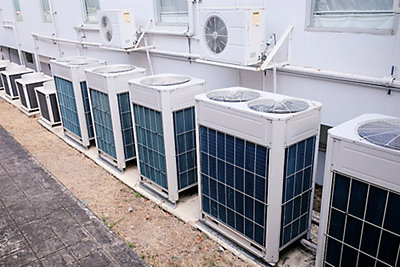What Are The Different Types Of AC & Heating Systems?

October 11, 2019
Here’s What Northern California Homeowners
Need To Know About Heating & Air Conditioning Units
If you’re thinking about replacing your HVAC (Heating, Ventilation, and Air Conditioning) system, the first question to ask is this:
What are the different types of AC & heating units that you can get installed in Northern California?
While many homeowners think it AC & heating systems are complicated, it’s actually fairly simple to get a good basic knowledge of your options.
Of course, the best way to know more is to schedule a free consultation and get customized advice and a quote. You can go here to schedule an appointment.
In the meantime, here’s a quick and easy lesson on the 4 types of AC & Heating Systems available:
The Four Types of HVAC Systems
Type #1: Heating and Air Conditioning Split System
A split system is an outdoor unit containing the condenser and compressor, and an indoor unit containing the evaporator coil and blower. Split-system central air conditioning is most popular type of residential heating and air-conditioning. The indoor unit is often connected to a furnace or heat pump.
HVAC split systems will typically have:
- An outdoor unit that houses the condenser coil, compressor, electrical components, and a fan.
- Refrigerant that circulates to and from the indoor and outdoor unit via a series of pipes (refrigerant lines).
- An evaporator coil that usually sits above the furnace inside the home.
- A blower that sends warm air over the cold evaporator coil, which absorbs heat from the air.
- Ducts that carry air throughout your building. Supply ducts pull in air while return ducts blow it out.
- A thermostat that controls the systems and sets your desired temperature.
- The occasional optional accessories for quality indoor air, such as air scrubbers, purifiers, humidifiers, UV lamps, and so on.
Type #2 Hybrid Heat Pump System
In a hybrid heating and cooling system, a heat pump (powered by electricity) is used in conjunction with a furnace that burns natural gas, propane, or fuel oil. Don’t be fooled by the name heat pump – these systems also cool your home.
In fact, heat pumps are air conditioners that can also work in reverse to efficiently heat your home. It’s one system that efficiently heats and cools your home.
These systems have a furnace for when temperatures dip below 40 degrees. A heat pump isn’t very efficient, and that’s when the furnace kicks on to do the heating.
On all but the coldest of nights (where you’ll need a furnace backup), a heat pump can take heat out of the air outside and transport it into your home. And in the summer, it functions just like an air conditioner, so you’ll get year-round energy savings from one product.
An ideal hybrid heat split system will have:
- A heat pump that heats and cools the refrigerant.
- A furnace, plus the evaporator coil for conversion of the refrigerant and circulation of air.
- Ductwork to channel the air around your building.
- The thermostat for adjusting and controlling the system.
- Optional accessories for improved indoor air quality.
Want more information on what the right type of AC & heating units are right for your home? Consultations and quotes are risk-free. Go here to schedule one.
Type #3 Ductless Mini-Split Heat Pump
A duct-free HVAC system provides a solution for spaces where conventional ducted systems aren’t compatible. They can also be great compliments to existing ducted types of HVAC systems.
Ductless mini-split units are installed directly into the zones of the home that need heating and cooling. You can have as many as four indoor air handling units (four zones or rooms) for each outdoor unit.
Ductless mini-split systems will have the following:
- The heat pump unit outdoors that contains the usual compressor, condenser, and fan.
- A fan coil that is compact.
- Wires and tubing for the refrigerant (only requires a 3-inch hole), connecting the outdoor unit to the fan coil.
- The thermostat (aka control panel).
- Optional accessories to clean the air and make it more pleasant before its distribution through the house.
Type #4 Packaged Heating & Air Conditioning System
A packaged HVAC system contains the compressor, condenser, and evaporator all in one unit, often located on a roof or near the foundation.
It is a good solution for homes and offices without adequate space for all the separate components of split systems. They are sometime used in small commercial buildings and often include electric coils or a furnace for heating.
Packaged HVAC systems include:
- The air conditioner/heat pump together with the evaporator/fan coil in one unit.
- Thermostat/control interface for a complete control of the system.
- Optional air quality improvers. Things like the air purifiers, cleaners, ventilators, or UV lamps, which are geared towards making the air extra clean before it circulates your home or office.
How To Find The Right AC & Heating System For Your Northern California Home?
You now know the basics of AC & heating system types. For an even better understanding, you can talk to a qualified expert at your home.
Don’t take risks with your home – reach out to the top HVAC installation company in Northern California. Go here to schedule a consultation.
